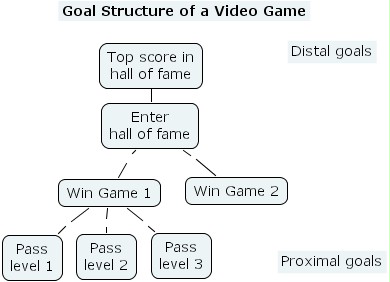updated for fall, 2005
"Motivation" is determined by the pattern of reinforcement and punishment.
For example, intermittent reinforcement produces greater persistence.
Fixed ratio schedules produce greater frequency (intensity) of response.
Attribution Theory (Weiner)
Identity is central to sociocultural motivation.
Suppose you were asked to design a new video game. How difficult would you make the game? What types of goals would you present to players?
One principle of motivation is that people want to do things that give most information about their competence.
Moderate difficulty levels (say, 50% chance of success) are more motivating because they give us more information.
They give us more precise information about the task and about our abilities.
In a motivational sense, moderately difficult tasks are more challenging than very easy or very hard tasks.
Ideally, task difficulty should be matched to the individual so that every learner is challenged.
The same idea applies when framing the question in terms of anxiety level, or arousal. Arousal levels are affected by cognitive and affective components. Too low a level of arousal and students won’t perform at their best on learning tasks, but too high a level will also interfere with performance.
Three general approaches to responding to anxiety:
Covington distinguished between mastery-oriented, failure-avoiding, and failure-accepting learners.
These concepts are similar to the mastery-approach and performance-avoidance concepts you may have used in your strategy reflection assignment.
Other types of goals are work avoidance goals and social goals.
Feedback describing accomplishment in relation to goals tends to be most effective.
There are many principles of motivation that derive from expectancy-value theory.
Expectancy = the perceived probability of success.
Value = the perceived value of success.
Motivation to do task = Expectancy X Value
Proximal goals are objectives that are attainable in a fairly short time. For example, studying a page in the textbook may be considered a proximal goal.
Distal goals are objectives that take longer to attain. For example, obtaining a university degree is a distal goal.
Proximal goals have higher probability, but lower value. Distal goals have lower probability, but higher value.
When distal and proximal goal are unconnected, they are less motivating. People are more likely to persist and achieve distal goals if they are connected with proximal goals. They are more likely to complete a proximal goal if it is connected to a personally meaningful distal goal (Miller & Brickman, 2004). For example, one reason why people are so strongly motivated to play video games is that they present a hierarchy of connected goals.

The Johnson brothers (Johnson & Johnson, 1999) distinguish among three interpersonal goal structures: competitive, individualistic and cooperative.
With "Teams-Games-Tournaments," Slavin (1990) showed that competition between teams can strongly motivate learners and build positive interdependence.
Chambers and Abrami (1991) cautioned that being on the losing team may have negative effects on the self-efficacy and motivation of lower achieving students.
Self-efficacy is task-specific.
Sources used to determine self-efficacy are: mastery experiences, arousal, vicarious experience, and social persuasion.
High self-efficacy sustains motivation, and persistence in the face of failure.
Learners with high self-efficacy attribute failures to lack of effort. Those with low self-efficacy attribute failures to lack of ability.
Self-efficacy is increased when learners experience success on meaningful, not-too-easy tasks. Setting proximal goals promotes this.
Self-efficacy is increased when learners are taught strategies and are rewarded for level of performance (not just participation).
Does the learner feel like she is in control, making decisions that will determine her success? Is she intrinsically motivated to learn?
Self-determination means that the student experiences a sense of choice, internal locus of control, and intrinsic motivation. This leads to greater persistence and goal achievement.
Deci and Ryan distinguish between controlling events that decrease self-determination, and information events that do not.
De-emphasize social comparison. For example, do not announce student grades when returning papers.
Instead, emphasize intra-individual comparison. For example, have students track their success rate over time.
Provide opportunities and scaffolding so that students achieve and demonstrate competence.
Chambers, B., & Abrami, P. C. (1991). The relationship between student team learning outcomes and achievement, causal attributions, and affect. Journal of Educational Psychology, 83, 140-146.
Johnson, D. W., & Johnson, R. (1999). Learning together and alone: Cooperation, competition, and individualization (4th ed.). Boston: Allyn & Bacon.
Malone, T.W., & Lepper, M.R. (1987). Making learning fun: A taxonomy of intrinsic motivations for learning. In R.E. Snow and M.J. Farr (Eds.), Aptitude, Learning and Instruction III: Conative and Affective Process Analyses. Hillsdale, N.J.: Erlbaum.
Miller, R. B., & Brickman, S. J. (2004). A model of future-oriented motivation and self-regulation. Educational Psychology Review, 16, 9-33.
Slavin, R. E. (1990). Achievement effects of ability groupings in secondary schools: A best evidence synthesis. Review of Educational Research, 57, 293-336.